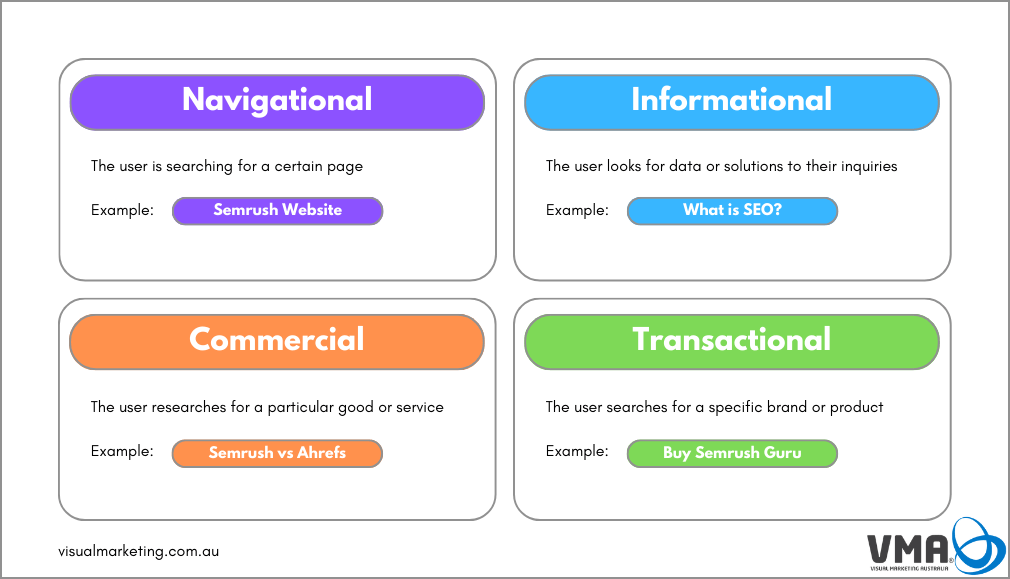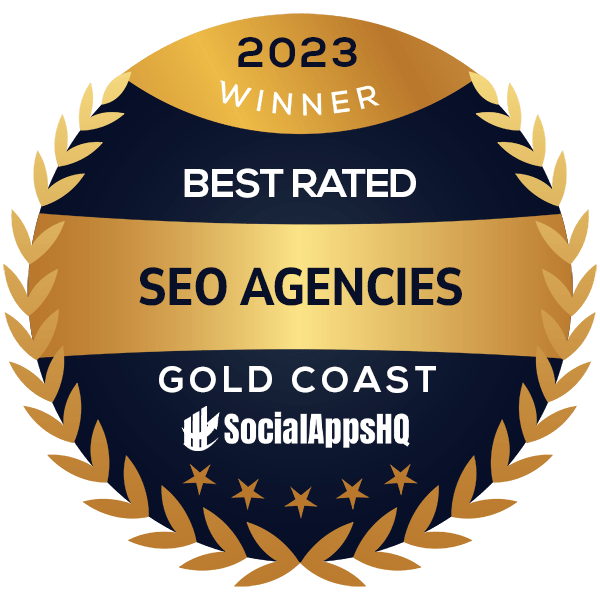The purpose that users have in mind when they type queries into search engines is called user intent, or search intent. It is the initial action when the user seeks answers, knowledge, information which defines the purpose of online search. Individual keywords are losing ground to user intent as the primary ranking element in content and search engine optimisation.
By recognising and optimising for user intent, content creators and website owners can provide more relevant and satisfying experiences to their target audience. Instead of solely focusing on keyword density or placement, they can tailor their content, structure, and overall approach to align with the specific goals and needs of users based on their search intent.
Types of Search Intent

Informational – when the user looks for data or solutions to their inquiries. Inquiries that typically begin with “What” This kind of search intent is highly prevalent. When a student needs to research the significance of ecosystems, for instance, they will first look for the definition of an ecosystem. Today, user intent plays a major role in both content and search engine optimisation, outweighing individual keywords as the most important ranking factor.
Navigational- the user is searching for a certain page and is aware of what it is that they hope to see. This indicates that the user is aware of what it is they are looking for already. For instance, a woman may go straight to a particular cosmetics firm’s website and peruse its offerings when she desires that particular brand.
Transactional – this is in reference to a user’s purchase; she/he wants to buy a good or service, but she/he is still looking for several stores that can meet her/his needs. This scenario arises when a consumer is prepared to buy but is still unsure about where to get the good or service. For instance, the user really needed a tent, but she was seeking for one that was both high-quality and could hold eight or ten people. Price was also a factor, so the user looked at a number of stores to find one that would work.
Commercial – consumers are looking for a particular good or service that they might need in the future. After doing several research on the product or services, they decide. They are merely a potential client, which is what sets it apart from transactional marketing. For instance, a mother is searching for a venue to host her daughter’s birthday celebration, but there are many important considerations to make, and the location needs to be reserved in advance.
What will be the Role of SEO?
As search engines continue to prioritise user intent as a key ranking factor, the role of SEO (search engine optimisation) in addressing search intent becomes increasingly important. SEO professionals and content creators need to shift their focus from solely targeting individual keywords to understanding and catering to the underlying goals and intentions behind user searches. After identifying the various categories of user intent (informational, navigational, commercial, and transactional), an effective SEO strategy should involve optimising web pages and content to align with the specific intent of the target audience.
1. Keyword research and mapping: While individual keywords are no longer the sole focus, keyword research is still valuable in understanding the language and terminology used by the target audience. SEO professionals should map keywords to the different types of user intent to understand the context and goals behind specific searches.
2. Content optimisation: With a clear understanding of user intent, content can be optimised to provide the most relevant and satisfying experience for users. This includes creating in-depth, educational content for informational queries, streamlined product pages and clear calls-to-action for commercial and transactional queries, and optimising site architecture and navigation for navigational queries.
3. On-page optimisation: Beyond the content itself, on-page elements such as titles, headings, meta descriptions, and structured data can be optimised to communicate the intent and purpose of the page to search engines, increasing the chances of ranking well for relevant queries.
4. User experience optimisation: SEO efforts should also focus on optimising the overall user experience, ensuring that the website or web page provides a seamless and intuitive experience that aligns with the user’s intent. This covers elements including navigational ease of use, mobile friendliness, and page load speed.
5. Continuous testing and analysis: As user behaviour and search intent evolve, SEO strategies should be continuously tested, analysed, and refined. This may involve conducting user research, analysing search data, and monitoring performance metrics to identify opportunities for improvement.
Conclusion:
In the end, real audience connections are the foundation of all successful websites and online enterprises. These days, it goes beyond just posting content online and optimising for arbitrary keywords. The true secret is to have a thorough awareness of your audience, including their needs, goals, and motivations. Consider this: every one of us is a human being with distinct needs, drives, and mental processes. Each of us has a distinct objective or intent in mind when we go online and begin looking for anything. We might be searching for a quick piece of information, investigating a possible purchase, or wanting to execute a specific action, like making a reservation for a flight.
You’ll find it much easier to create experiences and content that connect with your audience more deeply if you take the time to truly understand them and put yourself in their position. Like when you talk to a good buddy, you can adjust what you say and how you say it in a way that just clicks when you understand their viewpoint and what matters to them. Your website and your entire online presence follow the same rule. You can create experiences and content that feel really relevant and meaningful to your audience if you can understand the underlying motives and goals behind why they are seeking for something in the first place. Realistically reaching your audience where they are and providing them with what they need, when they need, it is more important than trying to manipulate the system or the search engines.
And let’s face it, as customers, that’s what we all desire. When we search online, we look for content and experiences that resonate with us and give us a sense of worth and understanding. By giving user purpose and audience comprehension top priority on your website and in your SEO campaigns, you’re not only raising your search engine rankings, but also building a more personal and meaningful relationship with the people you’re trying to reach.
A thorough awareness of the needs, objectives, and preferences of the target audience is essential for effective SEO in the context of search intent. SEO experts may increase the quality and relevancy of search results, which can improve user experiences and possibly result in greater ranks and visibility. They can do this by optimising content and website elements to align with these goals. In the end, SEO’s function in search intent is to close the gap between user queries and the information or experiences offered by websites. Businesses and content producers may remain ahead of the curve and provide more valuable and fulfilling search experiences by coordinating their SEO efforts with user intent.
You may also like:
SEO Black Hat vs. White Hat Techniques
The Future of SEO in a Privacy-First World
Crawlability and indexability in SEO
Sharing is caring!




